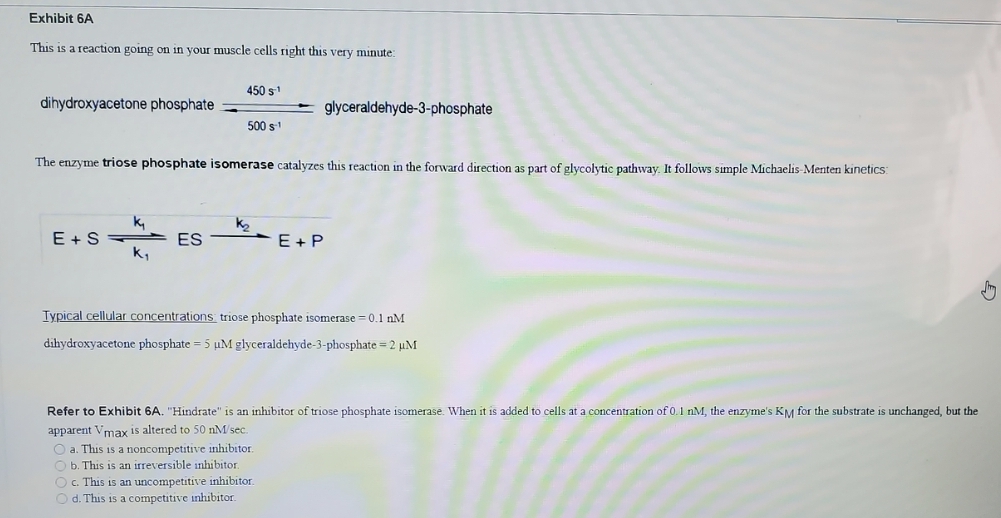Exhibit 6A This is a reaction going on in your muscle cells right this very minute: dihydroxyacetone phosphate E+S k₁ k₁ 450 S-¹ The enzyme triose phosphate isomerase catalyzes this reaction in the forward direction as part of glycolytic pathway. It follows simple Michaelis-Menten kinetics: ES 500 s¹ glyceraldehyde-3-phosphate E+P Typical cellular concentrations triose phosphate isomerase = 0.1 nM dihydroxyacetone phosphate = 5 uM glyceraldehyde-3-phosphate=2 µM O a. This is a noncompetitive inhibitor. Ob. This is an irreversible inhibitor. Refer to Exhibit 6A. "Hindrate" is an inhibitor of triose phosphate isomerase. When it is added to cells at a concentration of 0.1 nM, the enzyme's KM for the substrate is unchanged, but the apparent Vmax is altered to 50 nM/sec. Oc. This is an uncompetitive inhibitor. Od. This is a competitive inhibitor +
Exhibit 6A This is a reaction going on in your muscle cells right this very minute: dihydroxyacetone phosphate E+S k₁ k₁ 450 S-¹ The enzyme triose phosphate isomerase catalyzes this reaction in the forward direction as part of glycolytic pathway. It follows simple Michaelis-Menten kinetics: ES 500 s¹ glyceraldehyde-3-phosphate E+P Typical cellular concentrations triose phosphate isomerase = 0.1 nM dihydroxyacetone phosphate = 5 uM glyceraldehyde-3-phosphate=2 µM O a. This is a noncompetitive inhibitor. Ob. This is an irreversible inhibitor. Refer to Exhibit 6A. "Hindrate" is an inhibitor of triose phosphate isomerase. When it is added to cells at a concentration of 0.1 nM, the enzyme's KM for the substrate is unchanged, but the apparent Vmax is altered to 50 nM/sec. Oc. This is an uncompetitive inhibitor. Od. This is a competitive inhibitor +
Biochemistry
6th Edition
ISBN:9781305577206
Author:Reginald H. Garrett, Charles M. Grisham
Publisher:Reginald H. Garrett, Charles M. Grisham
Chapter18: Glycolysis
Section: Chapter Questions
Problem 11P
Related questions
Question
This a reaction going on in your muscle cells right this very minute:

Transcribed Image Text:Exhibit 6A
This is a reaction going on in your muscle cells right this very minute:
450s-1
dihydroxyacetone phosphate
500 s-1
glyceraldehyde-3-phosphate
The enzyme triose phosphate isomerase catalyzes this reaction in the forward direction as part of glycolytic pathway. It follows simple Michaelis-Menten kinetics:
E+S
k₁
k₁
k₂
ES
E+P
Typical cellular concentrations: triose phosphate isomerase = 0.1 nM
=
dihydroxyacetone phosphate 5 μM glyceraldehyde-3-phosphate = 2 μM
Refer to Exhibit 6A. "Hindrate" is an inhibitor of triose phosphate isomerase. When it is added to cells at a concentration of 0.1 nM, the enzyme's KM for the substrate is unchanged, but the
apparent Vmax is altered to 50 nM/sec.
a. This is a noncompetitive inhibitor.
b. This is an irreversible inhibitor.
c. This is an uncompetitive inhibitor.
d. This is a competitive inhibitor.
Expert Solution
This question has been solved!
Explore an expertly crafted, step-by-step solution for a thorough understanding of key concepts.
Step by step
Solved in 4 steps

Recommended textbooks for you

Biochemistry
Biochemistry
ISBN:
9781305577206
Author:
Reginald H. Garrett, Charles M. Grisham
Publisher:
Cengage Learning

Biochemistry
Biochemistry
ISBN:
9781305577206
Author:
Reginald H. Garrett, Charles M. Grisham
Publisher:
Cengage Learning